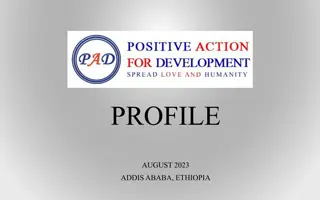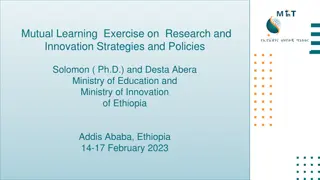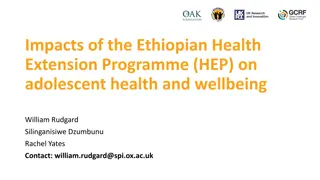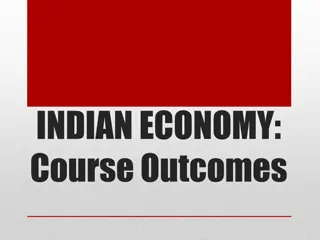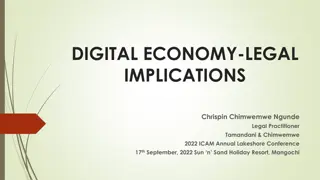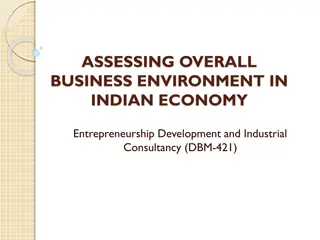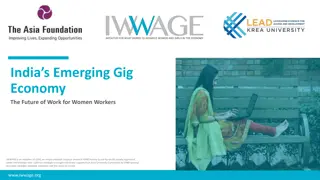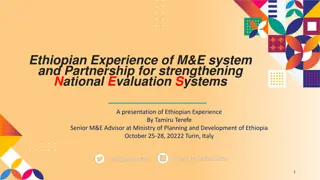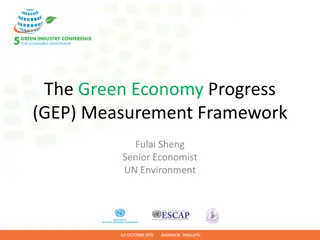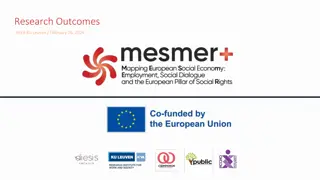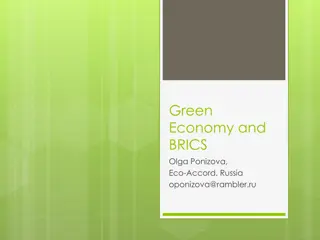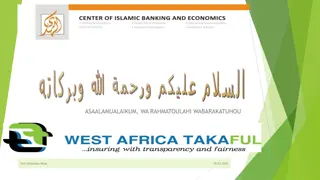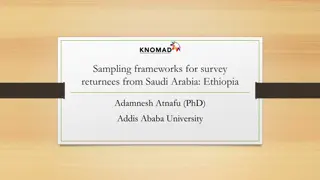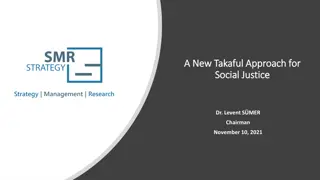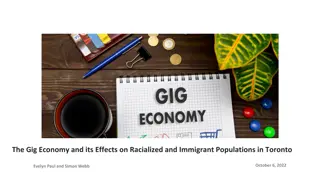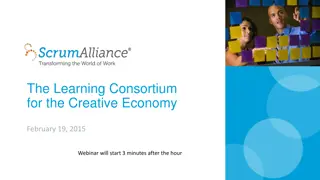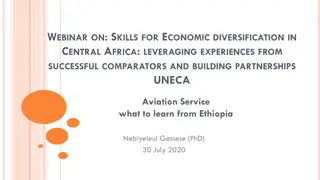The Impact of Takaful on the Ethiopian Economy and Somaliland's Progress
Explore the impact of Takaful on the Ethiopian economy with insights from Assegid G/Medhin, CEO in insurance and financial consultation. Delve into Somaliland's background, its clans, parts, and current state under President Muse Bihi Abdi. Learn about historical milestones, including the formation of the Somali Republic, Somaliland's unilateral declaration of independence, and recent agreements with Ethiopia. Witness the journey of Somaliland's self-declared independence and economic activities like livestock exports.
Download Presentation

Please find below an Image/Link to download the presentation.
The content on the website is provided AS IS for your information and personal use only. It may not be sold, licensed, or shared on other websites without obtaining consent from the author. Download presentation by click this link. If you encounter any issues during the download, it is possible that the publisher has removed the file from their server.
E N D
Presentation Transcript
THE IMPACT OF TAKAFUL ON THE ETHIOPIAN ECONOMY ASSEGED G/MEDHIN C.E.O AT(@t) INSUARNCE BROKERAGE & FINANCIAL CONSULTANT MARCH 5 , 2024 SOAMILAND
Somaliland: The Horn of Africas Breakaway State
Somali land is constituted out of five large family clans: The Dir, The Isaaq, The Darood, The Hawiye and The Rahanweyn
Somali land is constituted out of Six parts : Sannage Sool Togdheer Sahil Marodijeh Awdal
SOMALILAND: FACTS LEADER PRESIDENT MUSE BIHI ABDI Capital Hargeisa Area:177,000sq km Population: 5.7 million Languages: Somali, Arabic, English Life expectancy: 50 years Major export : The Economy of Somaliland largely relies on primary production and agriculture, where livestock is the main export of the country, which it ships to neighboring Djibouti and Ethiopia, as well as to Gulf states, such as UAE, Saudi Arabia and Oman. GDP : 3.1% (2023) Currency : Somaliland shilling
7th Century - Islam starts to make inroads into the area of modern-day Somaliland. 14th Century - The area's Islamic sultanates come under the suzerainty of the Christian Ethiopian Empire. 1527 - Sultanate of Adal revolts against Ethiopian rule and subsequently conquers much of Ethiopia, before being defeated with the help of the Portuguese in 1543. 1888 - Britain establishes the protectorate of British Somaliland though treaties with the local sultanates. 1899 - Islamic cleric Mohammed Abdullah rises against British rule, going on to establish the Dervish State, which survives until it is destroyed by British forces in 1920. 1960 - British Somaliland and Italian Somaliland become independent and merge to form the Somali Republic. 1991 - The former British Somaliland declares unilateral independence as Somaliland following the ousting of Somali President Mohamed Siad Barre, which plunges the rest of Somalia into anarchy. 2001 - More than 97% of the population votes to endorse the constitution adopted in 1997, in a referendum aimed at affirming Somaliland's self-declared independence. 2016 - Somaliland celebrates 25 years of self-declared independence, but remains unrecognized. 2024 - Ethiopia and Somaliland sign a memorandum of understanding for landlocked Ethiopia to use one of Somaliland's ports. Somalia describes the agreement as an act of "aggression".
2024 - Ethiopia and Somaliland sign a memorandum of understanding for landlocked Ethiopia to use one of Somaliland's ports. Somalia describes the agreement as an act of "aggression". 1STJANUARY 2024 ETHIOPIA ADDIS ABABA
Image caption, Livestock exports are an important source of revenue
THE IMPACT OF TAKAFUL ON THE ETHIOPIAN ECONOMY ASSEGED G/MEDHIN C.E.O AT(@t) INSUARNCE BROKERAGE & FINANCIAL CONSULTANT MARCH 5 , 2024 SOAMILAND
PRESENTATION HEAD LINE I.PROFILE : Country & Financial Institution. II. Ethiopian Economy III. Ethiopian Financial Sector A.BANKING SECTOR Conventional Interest Free Banking Service Interest Free Micro Finance B. INSURANCE SECTOR Conventional Interest Free Insurance service TAKAFUL Interest Free Insurance service MICRO TAKAFUL IV. Lesson Learned V. Recommendation VI. Contact
World Bank Ranking Currency Year Total Population GDP (Current US$) GDP Growth (Annual %) GDP- Per Capita (PPP) (USD) Imports (As % of GDP) Exports (As % of GDP) Inflation Consumer Price Annual % Unemployment Rate Structure of the Economy (% of GDP) Agriculture Industry Services 2023 120 Million 312 Billion 6.3 2812.50 6% 1% 40% 19.1% 37.54% 22.72% 36.64%
I.PROFILE : Country & Financial Institution. A. PROFILE A1. COUNTRY PROFILE. Population : 120Million UN 2023, 85% RULAR Area : 1.13.mln.sq.Kms. Life expectance: 56years(male ) ,59 years female GNP per capita: US$1000(WB 2023) Maine Export : coffee , Hides, oil seeds, Flowers, kchat , e.t.c Main food crops : wheat ,Barely ,Maize,Teff. The most dominant religion is orthodox and Muslim . It is beloved almost half of the population is Muslim .
Percentage under 15 15-29 30-44 45-59 60-74 75-84 85 and over above
Among accumulation, in particular through public infrastructure investments. Ethiopia s real gross domestic product (GDP) growth slowed down FY2021/22 due to multiple shocks including COVID-19, with growth in industry and services easing to single digits. However, agriculture, where over 70% of the population is employed, was not significantly affected by the COVID-19 pandemic, and its contribution to growth slightly improved compared to previous years. The consistently high economic growth over the last decade resulted in positive trends in poverty reduction in both urban and rural areas. The share of the population living below the national poverty line decreased from 30% in 2011 to 24% in 2016 and human development indicators improved as well. However, gains are modest when compared to other countries that saw fast growth, and inequality has increased Furthermore, conflicts in various parts of Ethiopia risk undermining the economic and social development progress the country has achieved. other factors, growth was led by capital from FY2019/20 to in recent years.
II. Ethiopia Economic With about 123 million people (2022), Ethiopia is the second most populous after Nigeria, and one of the fastest-growing economies in the region, with an estimated 6.4% growth in FY2021/22. However, it also remains one of the poorest, with a per capita gross national income of $1,020. Ethiopia aims to reach lower-middle-income status by 2025. Ethiopia s strong growth rate builds on a longer-term record of growth over the past 15 years where the country s economy grew at an average of nearly 10% per year, one of the highest rates in the world. nation in Africa
The government has launched a 10-Year Development Plan, based on its 2019 Home-Grown Economic Reform Agenda, which runs from 2020/21 to 2029/30. The plan aims to sustain the high growth achieved under the Growth and Transformation Plans of the previous decade while facilitating the shift towards a more private-sector-driven economy. It also aims to foster efficiency and introduce competition in key growth-enabling sectors telecom), improve the business climate, and address macroeconomic imbalances. (energy, logistics, and
Development Challenges Ethiopia seeks to chart a sustainable and inclusive in order to accelerate poverty reduction and boost Significant progress in job creation, as well as improved governance, will be needed to ensure that growth is equitable across society. Achieving these objectives will require addressing key challenges including the following: development path that is shared prosperity.
Addressing constrain private sector development, structural transformation, and generation of jobs. Reducing the incidence of conflict that has been having a substantial impact on lives, livelihoods, and infrastructure. The cessation of hostilities in the North in November 2022 is an important step in this direction. Overcoming the effects pandemic. Like the rest of the world, Ethiopia has been experiencing the unprecedented social and economic impact of the pandemic. While exports and foreign direct investment 2020/21 and jobs have been recovering, some lasting scars are likely employment levels have not recovered fully, some households and firms continue to report income losses, and poverty is estimated to have increased. macroeconomic distortions that of the COVID-19 rebounded in to remain. Urban
Addressing food insecurity, which is growing due to adverse weather events, locust invasion, conflict, and global conditions leading to high inflation of food prices. Frequent severe weather events alongside long-term impacts of climate change undermine agriculture and pastoral livelihoods as well as food security. The 2022 drought is the worst in forty years, severely affecting millions in the southern and eastern parts of the country. Overall, more than 20 million persons are facing severe food insecurity in 2023. Improving human capital. Ethiopia s Human Capital Index is at a low 0.38 (2020) which means that a child born in Ethiopia today will be 38% as productive when s/he grows up as s/he could be if s/he enjoyed complete education and full health. This is lower than the average for the Sub-Saharan Africa region but slightly higher than the average for low-income countries. Learning poverty stands at 90% and 37% of children under 5 years of age are stunted. Generating good jobs. workforce (with roughly 2 million persons reaching working age per year) The growing country s puts pressure on the
III. Ethiopian Financial Sector GNP per capita: US$1000(WB 2023) Maine Export : coffee , Hides, oil seeds, Flowers, kchat , e.t.c Main food crops : wheat ,Barely , Maize, Teff. Regulatory Body National Bank of Ethiopia (NBE) No. of Commercial Banks : 31( 2 gov t 29 private) No. of Commercial Banks : 18( 1 gov t 17 private) No. of Micro Finance : 47( All private ) No. of Insurance companies : 18( 1 gov t, 17private) No. of Interest Free Banks-window : 25( 1 gov t , 24 private ) No. of Interest Free Banks-full flagged 3( All private ) No. of Interest Free insurer-Wakala Model : 5 (All private) No. of Micro Insurers 3( 1 gov t, 2private) There is no Micro Takaful to date ( March 2024) There are 4 Islamic MIF(All private)
GOVERNANCE the country s financial sector is governed by central bank it is the supreme power hose of any regulatory issues . Ethiopia has passed different form of government 1. Modern imperial government where you found foreign investors in financial sector both in banking and insurance service 2. The military Government which command economy . 3. The EPRDF WHICH IS THE MARKET ECONOMY but the sector is blocked for foreigners only privatization 4. The liberal Economy ( The banking sector is opened for foreign investors .
RECENT CHANGES Introduction of ALTERNATIVE INSUARNCE TAKAFUL DIRECTIVE following the growth in interest free banking . The directive SIB/1/2020 permitted all insurer as well as reinsurer to do alternative insurance TAKAFUL . THE FIRST ETHIOPIAN ALTERNATIVE INSUARNCE PROVIDER IS GLOBAL INSUARNCE S.C with the help of ALHUDA CIBE . BUSINESS PROCLAMATION NUMBER 522/2008 AMENDED BY SSB/51/2011 n May 2019, Abiy Ahmed, the Ethiopian Prime Minister, expressed his approval in favor of the establishment of financial institutions entirely dedicated to Islamic finance. In June, the same year, the Central Bank issued a directive authorizing the creation of Islamic banks. DIRECTIVE NO. SBB/72/2019 ISSUED FOR FULLFLAGED ISLAMIC BANING SERVICE IN ETHIOPIA. ON 3RDOF OCTOBER 2022 , Ministry of council approved opening up of financial sector (banking service ) to foreign investors NBE official speaking on the basis of anonymity told the publication that this policy allows foreign investors to buy up to a 40% equity stake in existing Ethiopian banks, with a maximum of 5% allowed for individual foreign investors, 5% for non-bank investors and 30% for foreign banks.
3.1. ETHIOPIAN FINANCIAL SECTOR IN DETAIL Banks, insurance companies and micro- finance institutions are the major financial institutions operating in Ethiopia . The sector remained robust and played a significant role in facilitating socio-economic growth through its financial intermediation function. Accordingly, in 2021/22, new banks, including interest free banking entered in to the banking industry thereby raising the number of overall bank branches to 8,944 from 7,344 a year ago. They also accelerated their deposit mobilization (25.7 percent), loan collection (48.6 percent) and loan disbursement (29.9 percent). Their non-performing loan ratio was within the required ceiling of 5 percent and all other financial indicators revealed the safety and soundness of the sector. Likewise, insurance companies, microfinance institutions and capital goods finance companies have scaled up their outreach by expanding their network and diversifying their products. Their soundness was also duly ensured. All in all, financial intermediation access to finance and financial inclusion have steadily expanding.
3.1.1 BANK INDUSTRY The number of banks in Ethiopia has reached 31, of which, 29 were private and 2 state owned. These banks opened 314 new bank branches during the fourth quarter 2022/23 alone, thereby raising the number of bank branches to 11,281. As a result, population to bank branch ratio stood at 9,514.33. State own banks accounted for 20 percent of the total bank branches while private banks took 80 percent share. Of the total bank branches, 32.6 percent were located in Addis Ababa. State owned banks accounted for 36.2 percent and private banks 63.8 percent of the total capital. As a result, population to bank branch ratio reached 12 thousand people per branch. About32.7 percent of the total bank branches were located in Addis Ababa.At the same time, total capital of the banking industry showed a 31.7 percent annual growth to reach Birr 199 billion .
Fig. Branch Network and Capital of Banking System Percentage share from total Source: NBE Annual report fourth quarter 2022/23
3.1.2 MICRO FINANCE At the end of review quarter , the number of Micro finance institutes (MFIs) was 47. Their savings, creadits and total asset increased by 28.8%, 23.7% and 18% on annual bases respectively. Similarily , their capital showed a 20.5% annual decrease to reach to birr 9.6 Billion . All thee indicators siginify the relative importance or Micro Finance institut in providing access to financial service to low income and small sace enterprises both in rural and urban areas as showen in ( table 4.7)
Particulars2021/22 2022/23 % Change QIV Q III QIV A B C D=C/A E=C/B Total Capital 12,079,853.6 13,504,257.2 9,597,910.0 -20.5 -28.9 21,670,882.0 24,000,707.5 27,903,518.7 28.8 16.3 Saving 31,654,784.3 36,265,195.4 39,171,342.4 23.7 8.0 Credit 46,129,535.9 52,455,915.9 54,445,035.9 18.0 3.8 Total Assets
Interest Free Banking ( IFB) industry status As at December 31,2022 IFB Deposit IFB Financing S/N Bank Customer Base Total Balance Total Balance 1 Abay Bank 232,961.00 2,100,000,000.93 1,423,269,395.99 2 Abyssiniya 1,312,269.00 16,272,564,043.44 2,933,821,133.95 3 Awash 1,594,055.00 13,411,562,370.00 8,370,836,298.01 4 Amhara 23,480.00 278,797,858.13 No Financing 5 Buna 184,507.00 1,211,477,766.12 44,401,565.07 6 CBE 5,518,354.00 18,849,660,000.00 13,839,519,596.89 7 CBO 2,674,370.00 7,150,405,304.15 16,949,017,954.37 8 Dashin 546,635.00 122,336,170.04 5,070,750,627.40
9 Debub Global 26,119.00 2,900,000,000.00 No Financing 10 Hibret 160,000.00 2,367,432,538.00 1,900,000,000.00 11 Hijira 222,414.00 4,473,000,002.00 1,257,057,954.37 12 NIB 378,830.00 7,666,000,002.00 1,240,000,000.00 13 Oromia 946,000.00 342,264,819.00 6,050,000,000.00 14 Sinqee 132,687.00 1,800,000,002.00 31,295,061.00 15 Wegagen 150,000.00 1,800,000,003.00 304,000,000.00 16 Zaman 186,907.00 3,039,923,162.36 1,755,622,046.22 Total 14,289,588.00 83,785,424,041.17 61,169,591,633.27
3.1.3 Interest Free Micro Finance The establishment initiation of Islamic financial institutions in Ethiopia is not only in the banking sector. However, interest-free microfinance institutions are operating in Ethiopia without adequate legal firework. Table 6.shos that microfinance institutions are providing sharia- compliant microfinance services in the Muslim dominated areas of Ethiopia.
No. Name Islamic MFI Establishme nt Year 1 Harar Microfinance Institution (HMFI) 2014 2 Dire Micro Finance Institution (DMI) 2013 3 Somali Microfinance Institution (SMFI) 2012 4 Rays Microfinance Institution (RMFI) 2014
3.2 INSURANCE 3.2.1 conventional Insurance Insurance companies increased their total capital by 14.7 percent to Birr 11.1 billion whose share of private insurance companies was 73.6 percent and that of public insurance company was 26.4 percent (Table3 ). For the last several decade the contribution of insurance sector interterms of economic development is insignificant. it is stil less than 1 % of the GDP and penetration ration is also less than 0.10%.. Number of insurance company remains stagnant than expected increase since transformation and the size of capital though is beyond
3.2.1.1 Gross Written Premium The insurance industry has come a long way from performance at the beginning of domestic investors setting up insurance companies at the start of 1994/15 fiscal year. At the end of 1993/94 fiscal year, the total gross written premium (GWP) of the industry was Birr 254 million out of which the non-life insurance business accounted for the 246 million Birr. After a quarter of a century of business in which the number of private insurers grew from none to seventeen and the industry totaling eighteen companies (including the state owned EIC), the gross nonlife insurance premium reached at Birr 15.3 billion for the fiscal year ending as at June 30th2022. The insurance sector has been progressively growing over the years having average growth rate of 5.8% between the years 1994/95 to 1999/2000, 17.1% in the 2000s (2001-2010) and 19.2% from the 2010/11 fiscal year until the end of the 2019/20 fiscal years. In spite of the growing base in premium income, political instability and Covid-19 pandemic; the industry managed to register a staggering average growth rate of 17.5% in total and 16.66% in nonlife insurance business over the past five fiscal years. The following table illustrates the growth rate in the past five years by class of business.
Fiscal Years Class of Business 2021/22 No 216/17 2017/18 2018/19 2019/20 2020/21 536,250.0 0 352,776.0 0 435,654.0 0 1 Accident 260,469.00 294,117.00 323,751.00 2,266,706. 00 1,958,699 .00 2,651,904. 00 2 Aviation 458,788.00 574,376.00 771,169.00 Source (Own research) . 1,086,533. 00 773,631.0 0 954,120.0 0 3 Fire 487,361.00 580,813.00 674,959.00 1,155,500. 00 Engineer ing 707,300.0 0 742,437.0 0 4 507,691.00 594,291.00 570,587.00 Employe e Liability 160,567.00 180,100.00 190,426.00 181,451.0 0 176,022.0 0 178,542.0 0 5 357,009.0 0 285,310.0 0 325,962.0 0 6 Liability 221,856.00 260,246.00 264,046.00 968,988.0 0 649,323.0 0 655,553.0 0 7 Marine 532,261.00 472,560.00 556,296.00 6,856,136. 00 3,982,203.0 0 4,346,317.0 0 4,918,654 .00 5,567,981. 00 8 Motor 4,565,616.00
9 Pecuniary 429,814.00 453,614.00 456,850.00 508,543.00 773,215.00 1,014,489.00 92,468. 00 163,064. 00 208,752. 00 248,997. 00 629,840. 00 890,55 4.00 10 Others Non-Life Total GWP 7,133,4 78.00 7,919,49 8.00 8,582,45 2.00 10,579,2 55.00 12,915,2 08.00 15,313, 616.00 Source (Own research) . Life Business 360,092 .00 460,780. 00 514,310. 00 578,957. 00 958,751. 00 1,351,7 90.00 11 7,493,5 70.00 8,380,27 8.00 9,096,76 2.00 958,751. 00 13,873,9 59.00 16,665, 406.00 Industry GWP Growth Rate (Non-life ) Average five years Growth Rate (Non-life) 16.66 Growth Rate (life ) 27.96 11.62 Average Five years growth rate( life ) 31.75 Growth Rate (Industry) 11.83 8.55 Average Five years Growth Rate ( Industry) 17.50 11.02 8.37 23.27 22.08 18.57 12.57 65.6 40.99 22.66 24.34 20.12
4. Takaful Insurance Islam teaches us not only to have ldependence on Allah but also emphasizes on self protection against risks and threats. TakafulisanIslamicalternativetotheconventionalInsurance.Theword s Takaful has been derived from the Arabic verb Kafala which is also referred to as Kafalat in Urdu language, its means to guarantee, to help, to take care of one another s needs. The Takaful system has been structured keeping in view the Islamic system of Dait (Blood Money) which is the philosophy behind mutual assistance/Kafalat. Before going into further details about Takaful, we shall have a look at the conventional insurance system and the factors that led to it being considered Haram or illegal in the society. If the importance of insurance is observed in detailed, the following aspects emerge: To bear the risk/threat To protect others To share the loss Keeping in view the basic element so insurance, it is evident that now here in Islam the above-mentioned aspects are prohibited and that there is no reason to be considered haram or illegal since Islam itself encourages to help others.
4. Benefit of Takaful in the economy Strategic Issues Learning and growth perspective Develop Human Capital with the required competences, succession plans and performance management system for the proposed tactful Equipping the company with highly competent employees through well- developed competence framework in Islamic finance ; Continuous training and capacity building for all employees following the growth of the business. develop and implement a well-designed performance-based incentive management system; and well-founded career development and succession planning programs to be in place Create organizational culture that meets values, assumptions and artifacts set by the organization that create a sense of order, continuity, and commitments to meet the strategic objective of tactful insurance . and for this reason : Everyone is aware of the alternative insurance /takaful insurance Regular performance evaluation to create best team and reward each team for best performance Creating good perception about the alternative insurance through different mechanisms as set in the strategy. Develop ICT program to bring about efficiency and effectiveness in all organizational processes and service centers. IT investment is critical for financial service company, such as Takaful Insurance insurtech for Takaful business. Properly identified software for enterprise resource planning of that takaful insurance
4. Benefit of Takaful in the economy Internal process perspective Develop a system that brings about efficiency and effectiveness of all processes There will be standard quality, cycle time and cost measurement for every underwriting process There will be standard quality, cycle time and cost measurement for every claims management process There will be standard quality, cycle time and cost measurement for every marketing management process Every process will have its own qualitative and quantitative measures. There will be clearly identified risk management system with a clearly set risk appetite approved by sharia advisory board / Board of Directors . the risk management process and the system employed ultimately provide an overview of all processes in the organization so the decision will be made based on adequate information . Reputation/ image building through well-articulated and designed media platform for all personal sales, advertising, sales promotion and other Halal promotional systems. There will be a thorough and frequent checking of effectiveness of such media. Financial perspectives
4. Takaful Insurance .Customer Perspective Establish customer relationship management: - Ensuring a very Low level of customer complaint and continuous review of Company s complaint management system and a customer satisfaction designs in all systems Ensuring that there will be high persistent rate of insurance policies and renewal of at least 85% to 90% of existing business Increasing annual new business by 30-35% to be attracted every year A customer and employees satisfaction survey to be conducted at least every three years to assess Company s level of customer service and identify areas for improvement Ensuring presence in service centres in terms of service hours, branch network, innovative technology and door step services/ personal service for selected customers Increase market leadership in terms of availability and unlimited service offer Prompt claims service subject to clearly defined standard time, quality, cost and service standards Short leaflets for those coming for claims and buying insurance services explaining what to do and when to do. Prepare customer service charter that can be adhered through continuous monitoring and evaluation of the existing system. Set and sign memorandum of association on customer service standards for third party service providers (in terms of cost, time and other service quality parameters)
4.1 TAKAFUL MARKET OPPORTUNITY EXISTING GROSS WRITTEN CONTRIBU TION 2022/23 SHARE OF TAKFUL FROM AVERGAGE I/ FINANCING CON. GROSS WRITTENT PREMUIM INDU. 2021/22 TOTAL FINANCIN G (IFB) INDUSTRY LEVEL SHARE OF TAKFUL FROM IFB FINANCIN G TOTAL DEPOSIT(IFB) INDUSTRY LEVEL SHARE OF TAKFUL FROM IFB DEPOSIT NICE GROSS WRITTEN PREMIUM 2021/22 (%) 83,785,424,0 61,169,59 1,633.2752,608,400 16,600,00 0,000.00 0.0006 0.00074 41.17 0.0009 348,866,145.00 .00 0.02102 SEN.1= 0.001% 837,854.24 52,608,400 .00 50,271,25 4.42 55,052,63 2.47 52,644,095. 63 61,169,59 1.63 1,105,828.57 SEN.2= 0.2% 1,675,708.48 1,223,391. 52,608,400 .00 50,271,25 4.42 55,052,63 2.47 52,644,095. 63 1,105,828.57 83 SEN.3= 0.3% 2,513,562.72 1,835,087. 52,608,400 .00 50,271,25 4.42 55,052,63 2.47 52,644,095. 63 1,105,828.57 75 SEN.4= 0.4% 3,351,416.96 2,446,783. 52,608,400 .00 50,271,25 4.42 55,052,63 2.47 52,644,095. 63 1,105,828.57 67 SEN.5= 0.5% 4,189,271.20 3,058,479. 52,608,400 .00 50,271,25 4.42 55,052,63 2.47 52,644,095. 63 1,105,828.57 58 SEN.10 =1% 8,378,542.40 6,116,959. 52,608,400 .00 50,271,25 4.42 55,052,63 2.47 52,644,095. 63 1,105,828.57 16 SEN.11 =1.5%12,567,813.6 1 52,608,400 .00 50,271,25 4.42 55,052,63 2.47 52,644,095. 63 9,175,438. 74 1,105,828.57 578,692,40 0.00 552,983,7 98.67 605,578,9 57.17 579,085,05 1.95 TOTAL 58,649,796.8 3 103,376,6 09.86 1,105,828.57
Takaful Claims incurred as at JUNE 30 2023 Source : own research ( before ALLHUDA CIBE Muslim customers could not be covered for their losses and birr 49.424667.94 could be effected in form of compensation Takaful Class of Business Claims Paid % Motor 46,953,435 95.00 Fire 0 - G/A 240,000.00 0.49 Marine 988,493 2.00 1.00 Engineering 494,247 W/C 343,521 0.70 0.81 Miscellaneous 404,972 Total 49,424,667.94 100.00
INDUSTRY CLAIMS as of June 30/2023 ( Takaful is less costly) GROSS CONTRIBUTION OF TAKAFUL = 49, 424, 667.94 L/R = 0.37 Claims Incurred Premium Earned 49,424,667. loss ratio 94 133,300,00 0.00 Loss Ratio 37% HIGH CASE SENARIO Due to alternative insurance Takaful Ethiopian insurers could reach more than life insurance of conventional insurance of the last 30 years 40%
The impact of takaful on Ethiopian insurance sector and in the economy 1. Lowering Economic Inequality 2. Increasing Market Participation 3. Simplicity and transparency are encouraged 4. Linking Economic Activity to Financial Markets 5. Linking Savings and Investment 6. Refraining from Economic Bubbles (And Bursts) 7. Encouraging economic growth 8. Supporting Longer-Term Investment 9. Reducing adverse effects of harmful products & practices 10. In search of more stability
THANK YOU !!! THANK YOU !!! THANK YOU !!! THANK YOU !!!








